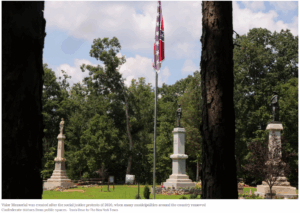GEORGIA: State Seeks to Add More Historic Black Sites to National Register
Most people love a good story, one that draws us in and keeps us on the edge of our chairs; one that is relatable and speaks to our imagination and touches our hearts. Whether fiction or nonfiction, a good successfully reels us in and takes us to another space and time. A good story leaves us wanting more.
Real, factual history offers intriguing stories that keep readers wanting more — even if they’re not history buffs. The 13th Colony in the United States, Georgia, has within its archive hundreds of untold stories that, if known and acknowledged, would change what we know of Georgia’s history and keep us asking for more.
A movement to tell the full story of not only our state but of our nation seeks to highlight and correct the lack of diverse and inclusive representation of people of color at historic sites. The overarching goal is to halt the perpetuation of inequality in our state’s history and to address systemic inequities in the U.S. In Georgia, that effort has taken the shape of developing historic context statements and nominating more places of Black historical significance to the National Register of Historic Places (NRHP) by reestablishing nomination criteria and considerations specific to historic Black places.
Historic context statements are documents used by professionals within the preservation field to better understand the significance of historic resources in a certain area. These statements provide a framework for evaluating these resources for importance and integrity. The objective is to ensure African American places and spaces throughout Georgia are identified and represented in the NRHP. The most recent African American context statement for Georgia was published more than 30 years ago in 1993, when acknowledgment of African American contributions and history remained minimal within the context of our state’s and nation’s historical records. The current efforts seek to correct and augment the record.
The historic preservation company Ethos Preservation was selected as the consultant team for the Georgia project. To accomplish this, an advisory committee of Georgians with knowledge of African American historic resources and/or who have lived experience with the preservation and designation of African American resources was formed. Together, Ethos and the advisory committee are collaborating to develop a comprehensive context statement that includes an in-depth history section, the identification of historic resource types, and themes, and guidance on how to best evaluate African American resources for listing to the NRHP.
Georgia’s efforts to include more Black sites into the National Register of Historic Places
The Ethos Project noted that as of March 2023 that only 162 out of 2,210 National Register listings in Georgia have “Ethnic Heritage: Black” listed as an area of significance in the NRHP database. This number is a considerably low considering Blacks have resided in Georgia since the first European colonizers. Ethos and the advisory committee believe the number of NRHP listings remains under-representative of the diversity of African American resources within our state.
Listings in the NRHP are connected to buildings, structures, objects, sites or districts. Sites with external architectural characteristics have been prioritized. Fewer Black heritage sites have been included, perhaps because of their simple appearances and/or because many Black historic sites have been erased through Urban Renewal and other public works projects that had underlying discriminatory objectives and outcomes. As a result, there is a sense of urgency to protect remaining sites connected to the Black experience.
Efforts to name and save physical spaces is important because being able to experience the tangible experience of a place makes it easier for future generations to connect with the history that belongs to it. Consider some of the well-known Black historic places in Savannah: First Bryan Baptist Church, First African Baptist Church, Charity Hospital and the Beach Institute. Being able to visit these places and learn about their history makes for an invaluable, authentic and tangible experience.
A walking tour through Savannah’s Black history
Sit on the original pews in the historic First African Baptist Church, 23 Montgomery St., and run your fingers along the ancient West Africa Arabic script. You’re tracing Black history. The pews were built by freed and enslaved Blacks after the church was organized in 1773, three years before the establishment of the United States.
Leave there and travel east to the Green-Meldrim House, 14 W. Macon St., to see the home where 20 Black ministers met with Gen. William T. Sherman in December 1864. Here, they engaged in conversation and proposed the desired 40 acres for post-Civil War freed Black families. Susie King Taylor worked in that house as a laundress and cook for Mrs. Green. You’re standing in Black history.
Stop by the Beach Institute African American Cultural Center, 502 Harris St., founded by the Colored Education Committee in 1865. Run your fingers over the bricks; they’ve been there since 1867, when the building was completed by free and formerly enslaved Blacks. Nearby you’ll find the Victorian-era King-Tisdell Cottage, 514 E. Huntingdon St., built in 1896 by prominent African American entrepreneurs Sara King and Robert Tisdell.
Continue to 22 Whitaker St. and look beyond the large buildings to travel back more than 200 years when Major William Royall sold coffins, caskets and cooling boards in 1878 to Black residents who had been denied service by white funeral homes following the yellow fever epidemic.

A short walk to 644 W. 36th St. takes you to the original site of Charity Hospital, erected in the late 1800s. In 1901 it became a training hospital for Black nurses. A few blocks away, the Ralph Gilbert Civil Rights Museum, 460 Martin Luther King Jr., Blvd., began as the Wage Earners Savings Bank in 1914. It was the second largest Black bank in America at the time. Inside, you experience local African American history.
These sites are listed as historic sites in the NRHP. But what places are missing that tell the rest of the stories in Savannah and throughout Georgia?
Perhaps you know of landmarks, landscapes and buildings that deserve attention and consideration. Georgia’s Full Story project is relying on you to help identify the stories untold. You may submit your idea/information/question at: to georgiasfullstory.com. By speaking up to become the tellers of our own story, we live the words and spirit of the Gullah Geechee community: “We Speak for We.”
–savannahnow.com






